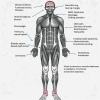Intensive Short-Term Dynamic Psychotherapy for Functional Somatic Disorders: A Scoping Review
- PMID: 40401139
- PMCID: PMC12090373
- DOI: 10.36131/cnfioritieditore20250201
Intensive Short-Term Dynamic Psychotherapy for Functional Somatic Disorders: A Scoping Review
Abstract
Objective: Functional somatic disorders (FSD) are extremely common amongst neuropsychiatric and other specialty medicine referrals. Intensive Short-term Dynamic Psychotherapy (ISTDP) is an emotionally focused form of brief therapy that has been researched and developed specifically for the diagnostic assessment and treatment of FSD, amongst other conditions.
Method: In this publication, we review the ISTDP theoretical underpinnings, the diagnostic assessment, treatment approach and evidence base.
Results: There are now over 50 publications evaluating ISTDP and its effect and processes in FSD. It has been demonstrated efficacious for the spectrum of functional somatic disorders, including chronic pain, functional gastrointestinal disorders, and functional neurological disorders among others. It has further been found more effective than cognitive behavioral therapy in the treatment of chronic pain. Further there is evidence that it is cost-effective in treating these conditions.
Conclusions: ISTDP is a broadly useful clinical tool in the assessment and treatment of FSD.
Keywords: emotion; psychodynamic; psychophysiological disorders; somatic symptoms; unconscious anxiety.
© 2025 Giovanni Fioriti Editore s.r.l.
Conflict of interest statement
Competing interests: None.
Figures
References
-
- Abbass, A. (2002). Intensive short-term dynamic psychotherapy in a private psychiatric office: Clinical and cost effectiveness. American Journal of Psychotherapy, 56(2), 225–232. - PubMed
-
- Abbass, A. (2005). Somatization: Diagnosing it sooner through emotion-focused interviewing. J Fam Pract, 54(3), 231–239. - PubMed
-
- Abbass, A. (2015). Reaching through resistance: Advanced psychotherapy techniques. Seven Leaves Press.
LinkOut - more resources
Full Text Sources


